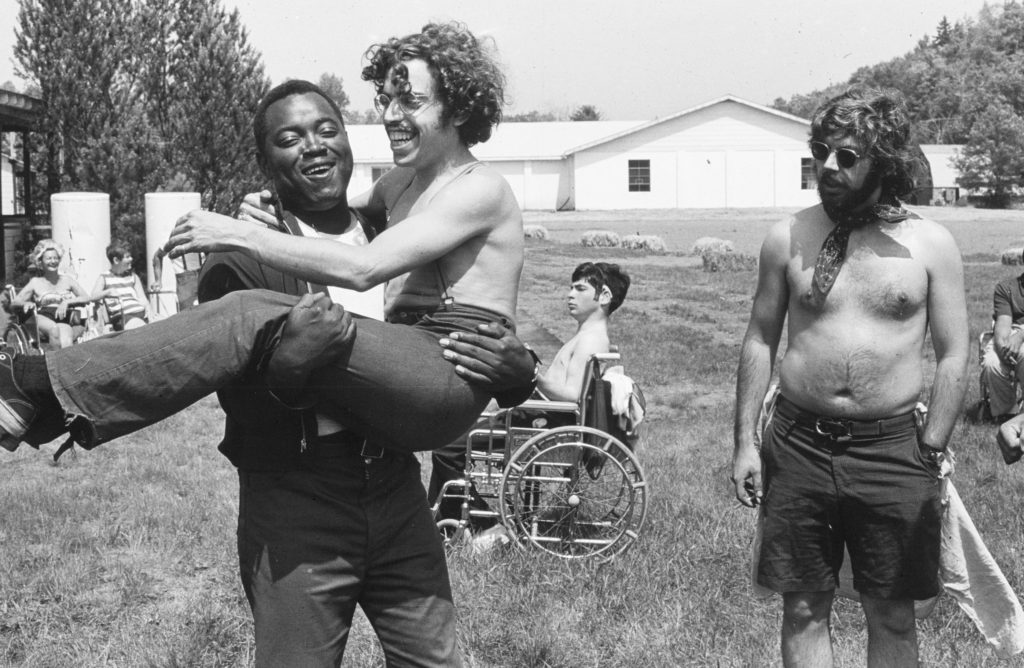Review: Crip Camp: A Disability Revolution (2020)

Most people nowadays see hippies as relicts of the past, a heterogeneous group of idealistic people that experimented with some of the foundations of the society and only partly fulfilled their noble causes while having a good time before they marched into the adulthood and got lost in the Bermuda triangle of work, family and house. Through their victories and defeats, hippies taught the world a lesson of methods in waging non-violent battles and not giving up. Between the sexual revolution, fight for the recreational marijuana use, anti-war protests, urge to save the ecology and fight for racial equality, one particular aspect of hippies’ struggle for civil rights tends to get out of perspective: fight for the inclusion of people with disabilities into society.
Nicole Newnham and James Lebrecht decided to tell the story of that particular fight in their documentary Crip Camp: A Disability Revolution produced by Obamas’ production company Higher Ground, known for the Oscar-winning documentary American Factory, and distributed by Netflix. Crip Camp also runs in the Oscar nomination, so it found its place in our Award Ticker section.
The titular camp was actually called ‘Camp Jened’, and it was located in the Catskills not far from the iconic Woodstock. ‘Camp Jened’ operated as a summer camp for young physically disabled people from the 50s till its demise due to the financial troubles in 1977. At first, it was a regular, structured summer camp, but the things changed when hippies took the leadership of it, making it a one-of-a-kind place where many of men and women felt accepted for what they were for the first time in their life.
As Lebrecht, serving as one of the co-writers and co-directors, as well as one of the principal subjects of the film, puts it, the role of the camp in the future fight for the civil rights for people with disabilities was immense and almost nobody knows about it. Crip Camp opens with the home footage from Jim’s childhood. We see him as a happy boy who does his best to overcome his spina bifida diagnosis. While growing up, he considered himself lucky to live at home and go to school (even on the “trial basis”), since kids like him usually got institutionalized early on. He liked his life, but he had no opportunity to see many kids like him. In the camp, he found himself “at home”: he met his first girlfriend there, he deepened his interest for music and he built up some sense of self-esteem that allowed him to go all the way to California to study the sound engineering.
Other stories from the camp include people talking about their romantic and sexual experiences (there was a clap outbreak once), the open-mindedness of the place and the spirit of friendship and comradery. One of the counsellors, Lionel Je’Woodyard, a Black man from Alabama, draws the parallels between the treatment of the disabled people world-wide and the treatment he suffered growing up in the South. Other campers talk about their relationship with their parents who tend to be over-protective, therefore constantly reminding them that they are disabled.
The camp part takes up only the first half of the film, since the teenagers from the “Class of ‘71” grew up and went on with their life. A lot of them moved to Berkeley, California, which was the best place for life with disability in America at that time. The revolution and the fight for inclusion, resulting first in the Rehabilitation Act (1973) and finally in Americans with Disabilities Act (1990), takes the second half of the film and it is connected to the camp since the former alumni of the camp played significant parts in the fight, especially in the culmination, the 504 Sit-In (1977). In that part, Judith Heumann, the leader of several NGOs that fought for the rights of the disabled people and also one of the former campers, becomes our protagonist.
At first glance, it seems that Crip Camp: A Disability Revolution is just a notch better than a regular, inspirational TV-style documentary that combines the on-camera interviews with archival and home footage. The film is also based on such tried-and-tested techniques, perfectly welded together by the editors Andrew Gersh and Eileen Meyer, and it works pretty well on the small screen, while the special treat is there for the fans of the rock oldies like The Grateful Dead, Jefferson Airplane and others.
The difference between Crip Camp (which is by no means revolutionary in the department of the documentary filmmaking, and it is a bit of a let-down) and a regular inspirational documentary is the lack of manipulation and pulling the heart-strings in an obvious, almost exploitative fashion. Crip Camp remains respectful to its subjects by making its most emotional moments look earned. Also, the way it blends a number of different topics and ideas in a comprehensible whole is just sublime. The revolution is an ongoing process.
Runtime: 106’
Country: USA
Language: English
Directed by: James Lebrecht, Nicole Newnham
Written by: James Lebrecht, Nicole Newnham
Cinematography by: Justin Schein
Editing by: Andrew Gersh, Eileen Meyer
Music by: Bear McCreary
Music supervisor: Aminé Ramier
Sound by: James Bloomfield-Misrach
Visual effects by: Max Colt Chizhevsky
Colourist: Brian Hutchings
Produced by: Sara Bolder, James Lebrecht, Nicole Newnham
Executive producers: Josh Brown, Howard Gertler, Barack Obama, Michelle Obama, Priya Swaminathan, Tonia Davis, Ben Braun, Matt Burke
Production companies: Good Gravy Films, Higher Ground Productions
Distribution by: Netflix
















